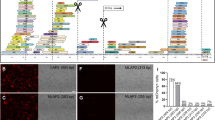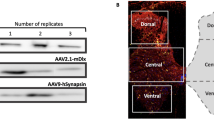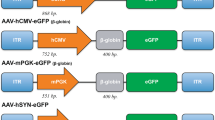Abstract
The INSM1 gene encodes a transcriptional repressor that is exclusively expressed in neuronal and neuroendocrine tissue during embryonic development that is re-activated in neuroendocrine tumors. Using the 1.7 kbp INSM1 promoter, an adenoviral HSV thymidine kinase gene therapy was tested for the treatment of neuroendocrine tumors. An unforeseen interference on the INSM1 promoter specificity from the adenoviral genome was observed. Attempts were made to protect the INSM1 promoter from the influence of essential adenoviral sequences and to further enhance the tissue specificity of the INSM1 promoter region. Using the chicken β-globin HS4 insulator sequence, we eliminated off-target tissue expression from the Ad-INSM1 promoter-luciferase2 constructs in vivo. In addition, inclusion of two copies of the mouse nicotinic acetylcholine receptor (n(AchR)) neuronal-restrictive silencer element (NRSE) reduced nonspecific activation of the INSM1 promoter both in vitro and in vivo. Further, inclusion of both the HS4 insulator with the n(AchR) 2 × NRSE modification showed a two log increase in luciferase activity measured from the NCI-H1155 xenograft tumors compared with the original adenovirus construct. The alterations increase the therapeutic potential of adenoviral INSM1 promoter-driven suicide gene therapy for the treatment of a variety of neuroendocrine tumors.
This is a preview of subscription content, access via your institution
Access options
Subscribe to this journal
Receive 12 print issues and online access
$259.00 per year
only $21.58 per issue
Buy this article
- Purchase on Springer Link
- Instant access to full article PDF
Prices may be subject to local taxes which are calculated during checkout






Similar content being viewed by others
References
Rindi G, Wiedenmann B . Neuroendocrine neoplasms of the gut and pancreas: new insights. Nat Rev Endocrinol 2012; 8: 54–64.
Bilbao G, Gomez-Navarro J, Curiel DT . Targeted adenoviral vectors for cancer gene therapy. Adv Exp Med Biol 1998; 451: 365–374.
Ghosh SS, Gopinath P, Ramesh A . Adenoviral vectors: a promising tool for gene therapy 63. Appl Biochem Biotechnol 2006; 133: 9–29.
Harrington KJ, Bateman AR, Melcher AA, Ahmed A, Vile RG . Cancer gene therapy: Part 1. Vector development and regulation of gene expression. Clin Oncol (R Coll Radiol) 2002; 14: 3–16.
Lo HW, Day CP, Hung MC . Cancer-specific gene therapy. Adv Genet 2005; 54: 235–255.
Miller N, Vile R . Targeted vectors for gene therapy. FASEB J 1995; 9: 190–199.
Qiao J, Doubrovin M, Sauter BV, Huang Y, Guo ZS, Balatoni J et al. Tumor-specific transcriptional targeting of suicide gene therapy 132. Gene Ther 2002; 9: 168–175.
Relph KL, Harrington KJ, Pandha H . Adenoviral strategies for the gene therapy of cancer. Semin Oncol 2005; 32: 573–582.
Rots MG, Curiel DT, Gerritsen WR, Haisma HJ . Targeted cancer gene therapy: the flexibility of adenoviral gene therapy vectors. J Control Release 2003; 87: 159–165.
Sadeghi H, Hitt MM . Transcriptionally targeted adenovirus vectors. Curr Gene Ther 2005; 5: 411–427.
Saukkonen K, Hemminki A . Tissue-specific promoters for cancer gene therapy. Expert Opin Biol Ther 2004; 4: 683–696.
Yao XL, Nakagawa S, Gao JQ . Current targeting strategies for adenovirus vectors in cancer gene therapy. Curr Cancer Drug Targets 2011; 11: 810–825.
Martin-Duque P, Jezzard S, Kaftansis L, Vassaux G . Direct comparison of the insulating properties of two genetic elements in an adenoviral vector containing two different expression cassettes. Hum Gene Ther 2004; 15: 995–1002.
Rohmer S, Mainka A, Knippertz I, Hesse A, Nettelbeck DM . Insulated hsp70B' promoter: stringent heat-inducible activity in replication-deficient, but not replication-competent adenoviruses. J Gene Med 2008; 10: 340–354.
Steinwaerder DS, Lieber A . Insulation from viral transcriptional regulatory elements improves inducible transgene expression from adenovirus vectors in vitro and in vivo. Gene Ther 2000; 7: 556–567.
Vassaux G, Hurst HC, Lemoine NR . Insulation of a conditionally expressed transgene in an adenoviral vector. Gene Ther 1999; 6: 1192–1197.
Ye X, Liang M, Meng X, Ren X, Chen H, Li ZY et al. Insulation from viral transcriptional regulatory elements enables improvement to hepatoma-specific gene expression from adenovirus vectors. Biochem Biophys Res Commun 2003; 307: 759–764.
Goto Y, De Silva MG, Toscani A, Prabhakar BS, Notkins AL, Lan MS . A novel human insulinoma-associated cDNA, IA-1, encodes a protein with “zinc-finger” DNA-binding motifs. J Biol Chem 1992; 267: 15252–15257.
Breslin MB, Zhu M, Lan MS . NeuroD1/E47 regulates the E-box element of a novel zinc finger transcription factor, IA-1, in developing nervous system. J Biol Chem 2003; 278: 38991–38997.
Mellitzer G, Bonne S, Luco RF, Van De CM, Lenne-Samuel N, Collombat P et al. IA1 is NGN3-dependent and essential for differentiation of the endocrine pancreas 181. EMBO J 2006; 25: 1344–1352.
Pedersen N, Pedersen MW, Lan MS, Breslin MB, Poulsen HS . The insulinoma-associated 1: a novel promoter for targeted cancer gene therapy for small-cell lung cancer. Cancer Gene Ther 2006; 13: 375–384.
Wang HW, Breslin MB, Chen C, Akerstrom V, Zhong Q, Lan MS . INSM1 promoter-driven adenoviral herpes simplex virus thymidine kinase cancer gene therapy for the treatment of primitive neuroectodermal tumors 7. Hum Gene Ther 2009; 20: 1308–1318.
Jones FS, Meech R . Knockout of REST/NRSF shows that the protein is a potent repressor of neuronally expressed genes in non-neural tissues. Bioessays 1999; 21: 372–376.
Schoenherr CJ, Anderson DJ . The neuron-restrictive silencer factor (NRSF): a coordinate repressor of multiple neuron-specific genes. Science 1995; 267: 1360–1363.
Mori N, Schoenherr C, Vandenbergh DJ, Anderson DJ . A common silencer element in the SCG10 and type II Na+ channel genes binds a factor present in nonneuronal cells but not in neuronal cells. Neuron 1992; 9: 45–54.
Bessis A, Salmon AM, Zoli M, Le NN, Picciotto M, Changeux JP . Promoter elements conferring neuron-specific expression of the beta 2-subunit of the neuronal nicotinic acetylcholine receptor studied in vitro and in transgenic mice. Neuroscience 1995; 69: 807–819.
Bessis A, Champtiaux N, Chatelin L, Changeux JP . The neuron-restrictive silencer element: a dual enhancer/silencer crucial for patterned expression of a nicotinic receptor gene in the brain. Proc Natl Acad Sci USA 1997; 94: 5906–5911.
Tverberg LA, Russo AF . Regulation of the calcitonin/calcitonin gene-related peptide gene by cell-specific synergy between helix-loop-helix and octamer-binding transcription factors. J Biol Chem 1993; 268: 15965–15973.
Chung JH, Bell AC, Felsenfeld G . Characterization of the chicken beta-globin insulator. Proc Natl Acad Sci USA 1997; 94: 575–580.
Bell AC, West AG, Felsenfeld G . The protein CTCF is required for the enhancer blocking activity of vertebrate insulators. Cell 1999; 98: 387–396.
Recillas-Targa F, Bell AC, Felsenfeld G . Positional enhancer-blocking activity of the chicken beta-globin insulator in transiently transfected cells. Proc Natl Acad Sci USA 1999; 96: 14354–14359.
Lan MS, Russell EK, Lu J, Johnson BE, Notkins AL . IA-1 a new marker for neuroendocrine differentiation in human lung cancer cell lines. Cancer Res 1993; 53: 4169–4171.
Pedersen N, Mortensen S, Sorensen SB, Pedersen MW, Rieneck K, Bovin LF et al. Transcriptional gene expression profiling of small cell lung cancer cells. Cancer Res 2003; 63: 1943–1953.
Lanigan TM, Russo AF . Binding of upstream stimulatory factor and a cell-specific activator to the calcitonin/calcitonin gene-related peptide enhancer. J Biol Chem 1997; 272: 18316–18324.
Bruce AW, Donaldson IJ, Wood IC, Yerbury SA, Sadowski MI, Chapman M et al. Genome-wide analysis of repressor element 1 silencing transcription factor/neuron-restrictive silencing factor (REST/NRSF) target genes. Proc Natl Acad Sci USA 2004; 101: 10458–10463.
Liu Z, Liu M, Niu G, Cheng Y, Fei J . Genome-wide identification of target genes repressed by the zinc finger transcription factor REST/NRSF in the HEK 293 cell line. Acta Biochim Biophys Sin (Shanghai) 2009; 41: 1008–1017.
Lunyak VV, Rosenfeld MG . No rest for REST: REST/NRSF regulation of neurogenesis 14. Cell 2005; 121: 499–501.
Mortazavi A, Leeper Thompson EC, Garcia ST, Myers RM, Wold B . Comparative genomics modeling of the NRSF/REST repressor network: from single conserved sites to genome-wide repertoire. Genome Res 2006; 16: 1208–1221.
Schoenherr CJ, Paquette AJ, Anderson DJ . Identification of potential target genes for the neuron-restrictive silencer factor. Proc Natl Acad Sci USA 1996; 93: 9881–9886.
Schoenherr CJ, Anderson DJ . Silencing is golden: negative regulation in the control of neuronal gene transcription. Curr Opin Neurobiol 1995; 5: 566–571.
Yoo J, Jeong MJ, Lee SS, Lee KI, Kwon BM, Kim DS et al. The neuron restrictive silencer factor can act as an activator for dynamin I gene promoter activity in neuronal cells. Biochem Biophys Res Commun 2001; 283: 928–932.
Namikawa K, Murakami K, Okamoto T, Okado H, Kiyama H . A newly modified SCG10 promoter and Cre/loxP-mediated gene amplification system achieve highly specific neuronal expression in animal brains. Gene Ther 2006; 13: 1244–1250.
Katz MH, Spivack DE, Takimoto S, Fang B, Burton DW, Moossa AR et al. Gene therapy of pancreatic cancer with green fluorescent protein and tumor necrosis factor-related apoptosis-inducing ligand fusion gene expression driven by a human telomerase reverse transcriptase promoter. Ann Surg Oncol 2003; 10: 762–772.
Lin T, Huang X, Gu J, Zhang L, Roth JA, Xiong M et al. Long-term tumor-free survival from treatment with the GFP-TRAIL fusion gene expressed from the hTERT promoter in breast cancer cells. Oncogene 2002; 21: 8020–8028.
Song JS, Kim HP, Yoon WS, Lee KW, Kim MH, Kim KT et al. Adenovirus-mediated suicide gene therapy using the human telomerase catalytic subunit (hTERT) gene promoter induced apoptosis of ovarian cancer cell line. Biosci Biotechnol Biochem 2003; 67: 2344–2350.
Bilsland AE, Anderson CJ, Fletcher-Monaghan AJ, McGregor F, Evans TR, Ganly I et al. Selective ablation of human cancer cells by telomerase-specific adenoviral suicide gene therapy vectors expressing bacterial nitroreductase. Oncogene 2003; 22: 370–380.
Messina M, Yu DM, Both GW, Molloy PL, Robinson BG . Calcitonin-specific transcription and splicing targets gene-directed enzyme prodrug therapy to medullary thyroid carcinoma cells. J Clin Endocrinol Metab 2003; 88: 1310–1318.
Minemura K, Takeda T, Minemura K, Nagasawa T, Zhang R, Leopardi R et al. Cell-specific induction of sensitivity to ganciclovir in medullary thyroid carcinoma cells by adenovirus-mediated gene transfer of herpes simplex virus thymidine kinase. Endocrinology 2000; 141: 1814–1822.
Morimoto E, Inase N, Mlyake S, Yoshizawa Y . Adenovirus-mediated suicide gene transfer to small cell lung carcinoma using a tumor-specific promoter. Anticancer Res 2001; 21: 329–331.
Adachi Y, Tamiya T, Ichikawa T, Terada K, Ono Y, Matsumoto K et al. Experimental gene therapy for brain tumors using adenovirus-mediated transfer of cytosine deaminase gene and uracil phosphoribosyltransferase gene with 5-fluorocytosine. Hum Gene Ther 2000; 11: 77–89.
Adachi Y, Matsubara S, Muramatsu T, Curiel DT, Reynolds PN . Midkine promoter-based adenoviral suicide gene therapy to midkine-positive pediatric tumor. J Pediatr Surg 2002; 37: 588–592.
Ring CJ, Harris JD, Hurst HC, Lemoine NR . Suicide gene expression induced in tumour cells transduced with recombinant adenoviral, retroviral and plasmid vectors containing the ERBB2 promoter. Gene Ther 1996; 3: 1094–1103.
Burgess-Beusse B, Farrell C, Gaszner M, Litt M, Mutskov V, Recillas-Targa F et al. The insulation of genes from external enhancers and silencing chromatin. Proc Natl Acad Sci USA 2002; 99 (Suppl 4): 16433–16437.
Shi Q, Wang Y, Worton R . Modulation of the specificity and activity of a cellular promoter in an adenoviral vector. Hum Gene Ther 1997; 8: 403–410.
Alemany R, Suzuki K, Curiel DT . Blood clearance rates of adenovirus type 5 in mice. J Gen Virol 2000; 81 (Pt 11): 2605–2609.
Tao N, Gao GP, Parr M, Johnston J, Baradet T, Wilson JM et al. Sequestration of adenoviral vector by Kupffer cells leads to a nonlinear dose response of transduction in liver. Mol Ther 2001; 3: 28–35.
Schiedner G, Hertel S, Johnston M, Dries V, Van RN, Kochanek S . Selective depletion or blockade of Kupffer cells leads to enhanced and prolonged hepatic transgene expression using high-capacity adenoviral vectors. Mol Ther 2003; 7: 35–43.
Worgall S, Wolff G, Falck-Pedersen E, Crystal RG . Innate immune mechanisms dominate elimination of adenoviral vectors following in vivo administration. Hum Gene Ther 1997; 8: 37–44.
Acknowledgements
This work was performed in conjunction with the Diana Helis Henry Medical Research Foundation. This work was supported by the Research Institute for Children, Children’s Hospital, New Orleans, Louisiana and Louisiana State University Health Sciences Center.
Author information
Authors and Affiliations
Corresponding author
Ethics declarations
Competing interests
The authors declare no conflict of interest.
Additional information
Supplementary Information accompanies the paper on Cancer Gene Therapy website
Rights and permissions
About this article
Cite this article
Akerstrom, V., Chen, C., Lan, M. et al. Modifications to the INSM1 promoter to preserve specificity and activity for use in adenoviral gene therapy of neuroendocrine carcinomas. Cancer Gene Ther 19, 828–838 (2012). https://doi.org/10.1038/cgt.2012.66
Received:
Revised:
Accepted:
Published:
Issue Date:
DOI: https://doi.org/10.1038/cgt.2012.66
Keywords
This article is cited by
-
Insulinoma-associated protein 1 (INSM1): a potential biomarker and therapeutic target for neuroendocrine tumors
Cellular Oncology (2020)
-
Tumor-specific promoter-driven adenoviral therapy for insulinoma
Cellular Oncology (2016)



